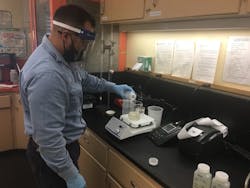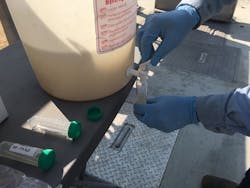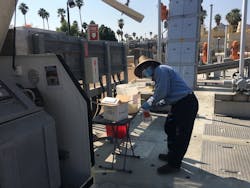Plant Profile: Palm Springs Wastewater Treatment Plant
About the author:
Carol Brzozowski is a freelance writer for WWD. Brzozowski can be reached at [email protected].
|
Location: Palm Springs, California Size: 10.9 million gallons per day Equipment: Primary settling, trickling filters, secondary clarifiers |
Early on during the COVID-19 pandemic, the virus seemed to be affecting the elderly at an alarming rate, notes Donn Uyeno, P.E., Palm Springs, California.
“Palm Springs is home to many retirees and older adults, which made it a population of concern,” Uyeno said. While the city has 48,000 residents, “on a busy weekend, the number of people in town can easily be more than 100,000 because of the easy drive from larger cities like Los Angeles and San Diego,” he added.
Treatment Train
The Palm Springs Wastewater Treatment Plant uses primary settling followed by trickling filters and finally secondary clarifiers to treat the wastewater pumped to the plant. After this process, 75% of the water is sent to the Desert Water Agency for further filtration and disinfection. Floodwater and storm water are sent to flood control channels or retention basins.
COVID-19 Wastewater Testing
In 2020, a few months after the COVID-19 virus outbreak, the Palm Springs City Council asked Veolia North America, which operates and maintains its wastewater treatment plant, to explore a wastewater testing program which had been piloted in several other U.S. municipalities after researchers determined its effectiveness as an extra tool for the detection of SARS-CoV-2.
The program has become so successful that the Coachella Valley Branch of the American Public Works Association (APWA) recognized the city of Palm Springs with a Project of Merit Award, while the APWA Southern California Branch recognized it as Project of the Year.
Constructed in 1960, Palm Springs’ wastewater treatment plant has a rated flow of 10.9 million gallons per day and serves a population of approximately 45,000. The first test to detect COVID-19 in the wastewater was conducted in early May 2020.
Joe Tackett, senior vice president for the Veolia North America municipal water business unit overseeing the Palm Springs project, said such testing was popular in other countries while just taking hold in the U.S.
“The city started to find out that there was value in testing the wastewater. We didn’t know yet at the time what asymptomatic was versus folks that were actually feeling ill and going to the hospital,” he said.
Recently, 4% of the population tested positive when data being collected from the wastewater plant showed 6%, with the 2% differential suggesting asymptomatic cases that have not been tested yet.
“Since a person will usually shed the virus in their waste within one to two days of infection, measuring wastewater was a way to capture visitors, asymptomatic people with COVID and those who are positive but don’t know it yet,” Uyeno said.
“Not everybody’s going to get tested because they’re asymptomatic,” Tackett said. “Home testing isn’t necessarily being reported to the health department. Employers may be telling employees for CDC guidance to stay home. If you’re not testing in the wastewater, the numbers shown on the nightly news are much lower in reality.”
How Wastewater Testing is Done
To do the test, 24-hour composite samples are taken twice weekly from the Palm Springs wastewater treatment plant influent and sent via dry ice to GT Molecular, a testing laboratory in Fort Collins, Colorado, for analysis. The sample measures the amount of COVID-19 virus per liter in its wastewater treatment system.
“Everyone’s going to use the restroom at some point in those 24 hours, so we’re making sure that we collect that 24-hour data,” Tackett said. “For our state-required NPDES permit, we have to take 24-hour composite samples anyway.”
Juan Garcia, operations manager, said everyone is wearing gloves and ensuring nothing is being contaminated. When city officials approached project manager Doug Loar about the COVID testing project, it had been the first time he had heard that it was possible to do so. Having real-time data and getting the results within the same week also impressed Loar.
Garcia had been familiar with the concept through news reports on universities doing COVID testing in wastewater. When he was approached by the Palm Springs City Council to explore the idea, Garcia had a difficult time finding a lab that was not already booked and would accept new work.
Testing Results
Some labs did it but would not offer a breakdown of how many people were possibly infected. The testing has enabled the city to take a more ‘“surgical” approach toward mitigating COVID because it provided the city with an accurate picture of the level of virus activity in area homes and businesses, supporting efforts to combat the spread of the disease.
The lab analysis showed that the Omicron variant moved the community into high numbers of those infected with COVID-19, Garcia said. The testing strengthened public trust in the Riverside County Public Health guidelines and increased support for mask mandates, closing of indoor restaurant service, limiting indoor retail, and hotel operations as well as relaxing restrictions when necessary.
About the Author
Carol Brzozowski
Carol Brzozowski is a freelance writer for Wastewater Digest. Brzozowski can be reached at [email protected].


